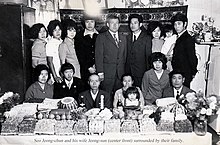
Korean cuisine has evolved through centuries of social and political change. Originating from ancient agricultural and nomadic traditions in Korea and southern Manchuria, Korean cuisine reflects a complex interaction of the natural environment and different cultural trends.

Soup soy sauce or "guk-ganjang" is a type of Korean soy sauce made entirely of fermented soybeans (meju) and brine. It is also a byproduct of doenjang production. Both lighter in colour and saltier than other Korean ganjang varieties, soup soy sauce is used mainly in guk (soup) and namul in modern Korean cuisine.

Korean royal court cuisine was the style of cookery within Korean cuisine traditionally consumed at the court of the Joseon Dynasty, which ruled Korea from 1392 to 1910. There has been a revival of this cookery style in the 21st century. It is said that twelve dishes should be served along with rice and soup, with most dishes served in bangjja (bronzeware).

Bosintang or tan'gogiguk is a Korean soup that uses dog meat as its primary ingredient. The meat is boiled with vegetables such as green onions, perilla leaves, and dandelions, and flavorants such as doenjang, gochujang, and perilla seed powder. It is seasoned with agastache rugosa before eating. The soup has been claimed to provide increased virility.
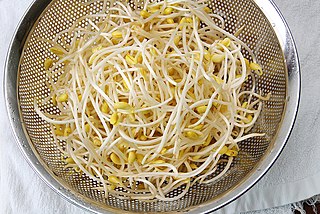
Soybean sprout is a culinary vegetable grown by sprouting soybeans. It can be grown by placing and watering the sprouted soybeans in the shade until the roots grow long. Soybean sprouts are extensively cultivated and consumed in Asian countries.

Banchan are small side dishes served along with cooked rice in Korean cuisine. Banchan are set in the middle of the table to be shared. At the center of the table is the secondary main course, such as galbi or bulgogi, and a shared pot of jjigae. Bowls of cooked rice and guk (soup) are set individually. Banchan are served in small portions, meant to be finished at each meal and replenished during the meal if not enough. Usually, the more formal the meals are, the more banchan there will be. Jeolla province is particularly famous for serving many different varieties of banchan in a single meal.

Miyeok-guk (미역국) or seaweed soup is a non-spicy Korean soup whose main ingredient is miyeok, or seaweed. It is traditionally eaten as a birthday breakfast in honor of one's mother and by women who have given birth for several months postpartum.

Sakhalin Koreans are Russian citizens and residents of Korean descent living on Sakhalin Island, who can trace their roots to the immigrants from the Gyeongsang and Jeolla provinces of present-day South Korea during the late 1930s and early 1940s, the latter half of the Japanese colonial era.

In Japan, it is customary to serve alcoholic drinks with snacks called sakana, shukō, or otsumami (お摘み). These are usually quite salty and served in relatively small portions. Sakana are usually more substantial than tapas, although they are not considered a meal since they are not accompanied by rice. Traditionally, the Japanese regarded sake, which is made from rice, as a substitute for white rice served in a standard Japanese meal, and as a result some Japanese do not eat rice and drink alcohol simultaneously.

Namul refers to either a variety of edible grass or leaves or seasoned herbal dishes made of them. Wild greens are called san-namul, and spring vegetables are called bom-namul. On the day of Daeboreum, the first full moon of the year, Koreans eat boreum-namul with five-grain rice. It is believed that boreum namuls eaten in winter help one to withstand the heat of the summer to come.
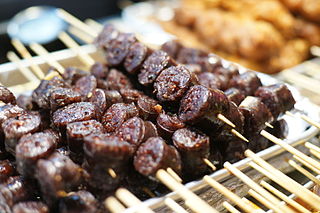
Sundae is a type of blood sausage in Korean cuisine. It is a popular street food in both North and South Korea, generally made by steaming cow or pig's intestines stuffed with various ingredients.
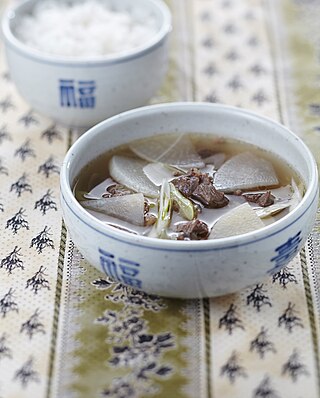
Guk (국), also sometimes known as tang, is a class of soup-like dishes in Korean cuisine. Guk and tang are commonly grouped together and regarded as the same type of dish, although tang can sometimes be less watery than guk. It is one of the most basic components in a Korean meal, along with bap, and banchan. In Korean table setting, guk is served on the right side of bap (rice), and left side of sujeo.

Doenjang-jjigae, referred to in English as soybean paste stew, is a Korean traditional jjigae, made from the primary ingredient of doenjang, and additional optional ingredients vegetables, seafood, and meat. It is one of the most iconic and popular traditional dishes in Korean cuisine, and is often eaten regularly regardless of occasion or time of day. Doenjang-jjigae was initially made with home-made doenjang; however, due to extensive industrialisation of soybean paste, households and restaurants nowadays use factory-made doenjang instead as their ingredient. From traditional to modern Korean cuisine, doenjang has become one of the most frequently used jang (sauce/paste). It is claimed as a national dish.

Bap is a Korean name for cooked rice prepared by boiling rice or other grains, such as black rice, barley, sorghum, various millets, and beans, until the water has cooked away. Special ingredients such as vegetables, seafood, and meat can also be added to create different kinds of bap. In the past, except for the socially wealthy class, people used to eat mixed grain rice together with beans and barley rather than only rice.

Siraegi (시래기) is a Korean ingredient prepared by drying the leaves and stems of a radish or, less commonly, of a napa cabbage.

Doenjang-guk (된장국) or soybean paste soup is a guk (soup) made with doenjang and other ingredients, such as vegetables, meat, and seafood. It is thinner, lighter, and milder than doenjang-jjigae. It is similar to the Japanese miso soup. It is sometimes mild, sometimes strong, and accompanied with rice most of the time.
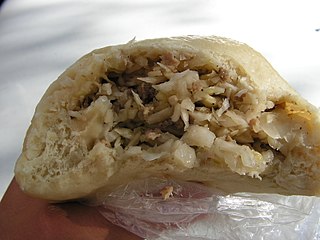
Pyanse or pigodi is a Sakhalin Korean steamed pie, bun, or dumpling stuffed with cabbage and meat. It is a popular dish in the Russian Far East, as well as in Koryo-saram communities of Central Asia.
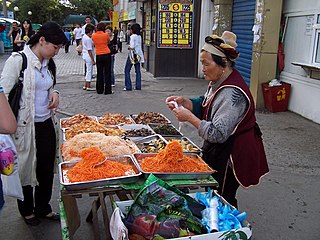
Koryo-saram are ethnic Koreans of the former Soviet Union. They have a distinct style of cuisine that is descended from Korean cuisine and influenced by the cuisines of various countries they have lived in. They are often considered distinct from Sakhalin Koreans, another Korean group from the former Soviet Union that has their own cuisine.

Korean Cuisine and Dining, sometimes translated as Korean Food Table, is a South Korean television documentary series that airs every Wednesday at 7:40 pm, South Korean time. It focuses on Korean cuisine, and is presented by Choi Bool-am. It aired its first episode on January 6, 2011.
